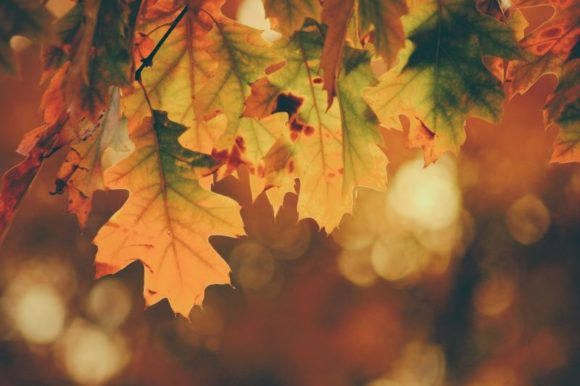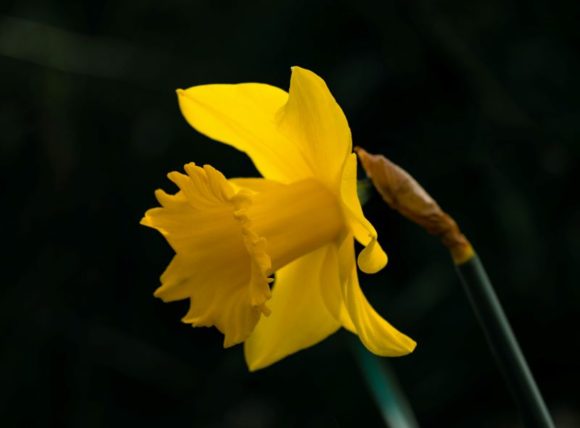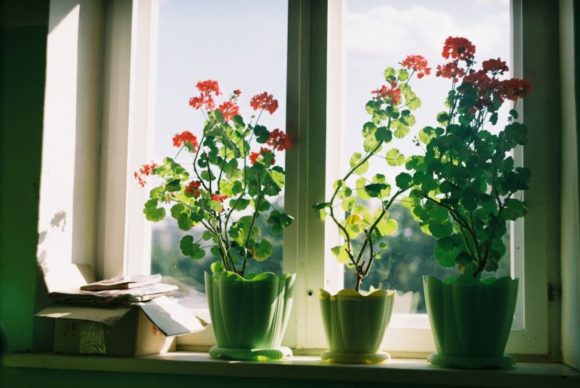
We have been fortunate here in New England to have the pleasure of a lovely summer – not too hot with adequate rain. Followed by a warm fall with more than enough rain into November to encourage healthy root growth for a vibrant spring next year. I am keeping my fingers crossed that this weather foretells a mild winter – we can only hope, but then again this is New England.
Planting bulbs
This year, due to the warm fall, the soil is still soft and warm for digging, which brings to mind, spring bulbs. Wear gloves when planting Daffodil bulbs, as these bulbs cause an irritation called a ‘lily rash’. Make sure you plant the bulb at a depth of at least three times the size of the bulb with the pointed end up and add composted manure around the planting holes. Daffodil bulbs need to be at least nine inches into the soil below the frost line for optimum bloom.

Dig a trench for the bulbs and scatter them in the trench. Bulbs can touch one another without a problem and by planting this way you will produce full dramatic show in spring.
Tulip bulbs should be planted twelve inches down to get them out of harm’s way as tulips are the caviar of the rodent family. I offer a suggestion to avoid this problem before planting by soaking them in an organic deer repellent then allowing them to dry in the sun. This will deter critters from eating them.
Another protection is to line the planting hole with gravel.
In the spring when the bulb foliage is about four inches tall, sprinkle more composted manure around all the bulbs you planted.
Other tasks for November
I hear you saying, “Okay Maureen, I’m ready to plant the bulbs but what else is there to do in the garden”? Folks, there are a number of things to get you out in the garden this fall.
The most important task is to apply a few inches of composted manure on all planted borders with a light layer of natural brown mulch on top. By doing this you will continue to build the humus component in the soil.
Before the snow flies, any construction projects that you have in mind can be accomplished. This includes stonework and carpentry, building decks, and mending fences. Building dry laid stonewalls, walkways, patios and digging ponds. This is definitely labor-intensive work, but at this time of year you won’t be uncomfortably hot. Make sure to stretch, take breaks and drink lots of water.
When the weather is inclement, work under a construction tent when building walls, decks or digging ponds. Or build trellises, pergolas, and arbors and fences in a shed or garage. The added advantage to the hard labor is that it keeps one in shape, especially with those fattening holiday meals looming on the horizon.
If you are not able or do not want to do the work yourself, now is the time to call in a professional to do the work so that the project is completed before you plant in spring.
Each year, harsh winter wind damages much of the foliage of broadleaf evergreens. Rhododendrons, mountain laurel and azaleas are particularly vulnerable as cold wind drains them of much-needed moisture. Broadleaf evergreens with their shallow root system need a good store of water going into the winter. We have had reasonable rain but need more this fall; the rain helps the broadleaves survive, as they will continue to lose water vapor through the cold months.
Many of you have said that you notice the harsh winds of the past two winters caused the foliage on many rhododendrons to become brown and brittle. This happens when the soil freezes so that plant roots, cannot take up water to make up for moisture lost from water vapor. Dehydration is the result causing brown or wind burnt foliage.
I do not go overboard with wrapping evergreens with burlap in winter. My white pines, Colorado blue spruce and Fraser firs are at least 50 years old and well-established so no worries about damage. However, there are exceptions, with plants that require a burlap wrap. Among those are evergreens planted in September. Among those is the Dwarf Alberta Spruce, so prone to wind burn.
The Albertas should be covered with one layer of burlap, loosely wrapped.
If the evergreens are planted close to a road and exposed to salt spray from the snow trucks and ploughs, burlap three feet up from the base may help.
The best idea however, is not to plant them close to the road or plant salt-tolerant species like Juniper.
At the base of all evergreens, spread a three-inch layer of leaves or fine bark mulch, composted manure and peat around the base of the trunk. Following a heavy snowstorm when evergreen branches are weighed down with snow gently brush the snow off with a broom.
The leaves of the deciduous trees fell fast this fall due to the recent storms. Either you or a nimble person should climb a ladder and remove leaves from gutters and drainpipes. Water from clogged gutters and pipes falling onto foundation plantings causes damage to the plants below.
Peonies and Perennials … and Vegetable Gardens
Now in November, following the first hard frost, cut Peonies down to within six inches from the ground, adding just a small amount of composted manure around the base.
I leave up my spent perennials until next April. The soft grays browns and yellows compliment the muted hues of a winter landscape and our feathered friends enjoy the seed heads.
Any leftover vegetables in the vegetable garden should have been turned into the soil. Add a light application of manure to the vegetable garden and plant a cover crop of buckwheat, alfalfa or white clover, to minimize erosion. In spring, turn the cover crop into the soil as green manure.
Power Tools, Irrigation Systems & More
Take any of your power tools that require repair or sharpening into the shop now. The repair shops are less busy now than in the spring. Clean your tools off in a bucket of sand, the roughness of the sand will help clean off soil and debris, then oil and grease wooden handles to preserve them and prevent splinters. Hang them neatly on hooks in the garage or shed and not just “higgledy-piggledy” in a pile
If you have an inground irrigation system, blow out the lines or have this done professionally. Also coil your hoses and store in shed or garage, and shut off outdoor faucets.
Put a bag of potting soil in the corner of the garage or basement, it will come in handy for repotting houseplants, bulb forcing or starting seeds in the spring. A supply of peat, composted manure, sand and vermiculite is also useful. Also put a bag of topsoil and some mulch under cover so that you can cover the shallow roots of evergreens if they push above soil surface due to frost heave.
Houseplants

The best time to transplant houseplants is during the growing season beginning in April. However, if you need to repot some houseplants that have outgrown their container, transplant to a clean pot only two inches larger than the original as plants like to be compact; add new potting soil and water.
Container geraniums and begonias brought indoors should be placed in a sunny window to be enjoyed. In February, cut the plants down to about six inches from the soil surface and water them.
Water houseplants, early in the day; not in the evening, as plants do not like to have wet feet at night. Water them only when the top four inches of soil is dry to the touch. Once a month stand them in the bathtub or sink and spray the leaves with lukewarm water to remove any dust, dirt, white fly or aphids. Do not get allow water to get on the leaves of African violets.
Bulbs for forcing
Paper white Narcissus bulbs are great for forcing. I force these bulbs in pebbles, but you may use potting soil if you wish and keep the pebbles or soil moist. Put the Narcissus bulbs in tall containers. I use tall clear glass vases, which help support the stems. I anchor the bulbs with pebbles, keep the pebbles moist and place the containers in a cool dark place. As soon as you see root growth and some leaf growth, which is in about a month, bring the bowls into medium light, keeping the pebbles or soil moist at all times.
I force about a dozen bulbs at a time and the remainder I store in the vegetable keeper in the refrigerator in a brown paper bag away from food. I bring them out and pot them up a few at a time so that I have a succession of fragrant bloom throughout the winter.
Herbs
Grow pots of parsley, dill, basil and other herbs in a sunny window, delicious fresh herbs for cooking and salads through winter.
Roses
Remove any dead or diseased leaves from Roses and pick up any Rose debris off the ground. If you notice disease like black spot in the debris, do not put it in your compost pile; throw it away in the garbage. Mound soil, composted manure and mulch around the base of the Roses. The mounding helps maintain a constant temperature around the Rose.
If the Roses are grown in an exposed area, which makes them vulnerable to drying winter winds, cover the plant with one loose layer of burlap or use a rose cone. Make sure all climbers Roses and other Vines are securely fastened to the fence or trellis.
Bird feeders
Set up your bird feeders where you are able to enjoy seeing the birds. Preferably place the feeders near to some low shrubs or small trees sheltered from the wind; birds like to flit from these protected spots to the feeder. Offer a varied menu for different birds. Birds enjoy a recipe I received from my stepmother in England; a lump of suet embedded with peanuts or hollowed out pinecones filled with peanut butter.
To prevent squirrels from raiding the feeders, set up a baffle and sprinkle cayenne pepper in the birdseed and on the suet feeders; the heat does not bother the birds and squirrels will stay clear. I am aware that hungry squirrels can jump vertically five feet; but don’t worry if you happen to be a squirrel lover; they always manage to get food from some feeder.
This is the time of year when we gardeners can pause and with the previous season still fresh in your mind, say, “this worked,” and “that I will never try again.” It is worthwhile to take a leisurely stroll around the garden before the snow flies in the next few weeks.
Look at the garden, squarely and soberly, making notes as you go to plan for next season. Plan as you stroll, writing down your impressions, making sketches and lists, and saving them for your winter armchair gardening.
Enjoy the Thanksgiving holiday and I’ll see you in your garden next month.

About the author: Maureen Haseley-Jones is a member of a family of renowned horticultural artisans, whose landscaping heritage dates back to the 17th century. She is one of the founders, together with her son Ian, of, ‘The English Lady Landscape and Home Company.’ Maureen and Ian are landscape designers and garden experts, who believe that everyone deserves to live in an eco-conscious environment and enjoy the pleasure that it brings. Maureen learned her design skills from both her mother and grandmother, and honed her horticultural and construction skills while working in the family nursery and landscape business in the U.K. Her formal horticultural training was undertaken at the Royal Botanic Gardens at Kew in Surrey.
Contact Maureen at maureenhaseleyjones@gmail.com